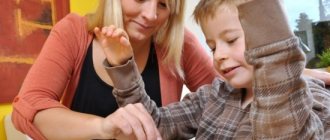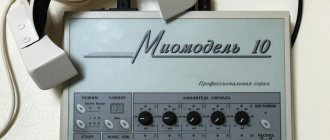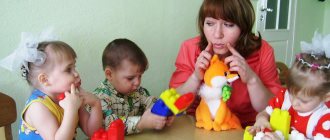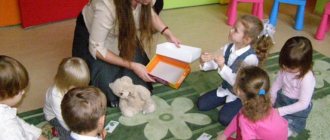Phonetic-phonemic underdevelopment of speech is characterized by a delay in speech development, primarily expressive speech. This condition is often associated with underdevelopment of the cortical parts of the brain, which take on a mature “look” as the baby grows older. If a child’s problems persist after three years, he may be diagnosed with “speech development delay” (SDD). In this case, active speech therapy work begins, aimed at correcting the disorders. Additionally, drugs for speech development can be used: nootropics and drugs that improve the condition of nerve cells.
Information about the disease
The child’s speech development goes through a number of successive stages, which are closely monitored by the pediatrician and parents. As you grow older, you observe a gradual enrichment of your vocabulary, the formation of correct pronunciation and understanding of what others say. It is believed that a child’s speech development continues actively until the age of 3. During this time period, the child enters kindergarten, where he begins to actively communicate with peers and teachers.
At the age of 3 years and older, a diagnosis of speech delay may be made. Doctors believe that this pathology is manifested by a simultaneous violation of all parts of speech: grammar, phonetics and vocabulary. As a rule, suspicions about the presence of a disorder arise earlier, but RDD is diagnosed only after reaching the age of three. Until this time, a speech therapist actively works with the child, which in most children leads to the formation of normal speech.
In the absence of correction, mental retardation can cause the development of dysgraphia and dyslexia, characterized by impairments in writing and reading, respectively. This, in turn, negatively affects the child’s memory, attention, as well as the learning process in kindergarten and school.
Delayed speech development is a consequence of a functional disorder in the maturation of the cortical parts of the brain and the articulatory apparatus. In this regard, therapy for such a condition is always carried out jointly by a pediatrician and a speech therapist using medications, speech therapy exercises and other methods.
A child speaks poorly at 3 years old: how does a delay with intact intelligence manifest itself?
Delayed speech development refers to a situation in which a baby acquires speech later than the age norm.
Signs of speech delay
This phenomenon is characterized by the following features:
- qualitative and quantitative underdevelopment of vocabulary;
- unformed expressiveness of oral speech;
- lack of coherent speech by 3 years;
- incomplete pronunciation of words;
- inability to express your wishes.
For your information! Delayed speech development can be determined through a visit to specialists. Also, if the parents communicate a lot with the child, then the presence of this problem will become obvious to them.
How to determine the level of speech development in a child at home?
With due attention, it is not difficult to determine the level of speech development even at home.
For your information! The main parameter that you need to pay attention to is how different the level of speech development of a particular child is from this indicator among peers, in other words, how much worse or better he speaks.
In addition, there are special tables that reflect the correspondence of the dynamics of a child’s speech development to the age norm. This information is publicly available and understandable even to a layman. By comparing the development of a child’s speech with such a table, you can identify the problems and gaps he has and help get the baby talking.
Norms of speech development
By this age, the child should have coherent speech, and not moo and react inappropriately. He should already be able to construct sentences.
How to teach a child to speak the sound [r] without a speech therapist at home
By the end of the third year of life the following should be observed:
- clarity of speech;
- improving pronunciation;
- the ability to name all surrounding objects;
- the appearance in the vocabulary of such parts of speech as pronouns, adjectives and prepositions;
- attempts to coordinate words (use of genders, cases and numbers);
- the ability to memorize and retell short works of art.
For your information ! It is during this period that children, whose speech apparatus develops in accordance with age norms, show a special desire to communicate with both adults and peers. They learn to establish verbal contacts, learn habits, and begin to help.
Necessary treatment
An effective approach to eliminating speech disorders is comprehensive, including speech therapy sessions, medications and improving the social situation in the family. A psychologist and psychotherapist works with the child’s parents and the child himself. This allows you to improve the quality of communication in the family and guide parents towards regular communication.
A common cause of RRD is articulation disorder associated with pathology of the tongue, teeth, lips or jaws. To eliminate them, special gymnastics are performed, aimed at improving the functioning of the articulatory apparatus. Additionally, speech therapy massage is used to relieve tension from facial and chewing muscles. Physiotherapy is of additional importance in therapy: electrical stimulation, LOGO+ and other techniques. They can help improve the function of the cortical and subcortical parts of the brain, eliminating speech defects.
Improving metabolic processes and protecting nerve cells from damaging factors is possible with the use of drugs from various pharmacological groups. Only a specialist should select drugs, since they all have certain indications and contraindications for their use.
Pharmacotherapy. Medicines used to treat speech disorders
In the complex rehabilitation of children and adolescents with speech disorders, in addition to speech therapy, pedagogical and psychological correctional measures, drug therapy plays a significant role, used at all stages. It must be pathogenetically substantiated, differentiated in each specific case, and strictly individual for the patient. Pathogenetic medications include drugs that primarily affect residual cerebral symptoms. For rehabilitation treatment, the following groups of drugs are used: 1) dehydration; 2) neurometabolic cerebroprotectors; 3) absorbable agents; 4) angioprotectors; 5) vitamins and their analogues; 6) anticonvulsants; 7) means regulating emotional and behavioral reactions; hepatoprotectors.
It must be pathogenetically substantiated, differentiated in each specific case, and strictly individual for the patient. Pathogenetic medications include drugs that primarily affect residual cerebral symptoms. For rehabilitation treatment, the following groups of drugs are used: 1) dehydration; 2) neurometabolic cerebroprotectors; 3) absorbable agents; 4) angioprotectors; 5) vitamins and their analogues; 6) anticonvulsants; 7) means regulating emotional and behavioral reactions; hepatoprotectors.
1. Dehydration agents occupy an important place in rehabilitation therapy. They help reduce hypoxia of nerve cells, improve cerebrospinal fluid dynamics and relieve symptoms associated with its disturbance. For this purpose, the following are used: a 50% solution of glycerol in combination with potassium-sparing diuretics (triampur, veroshpiron), a 10–25% solution of magnesium sulfate (orally or intramuscularly).
Dehydration is carried out for 1–2 weeks in maximum doses, and then for 4–5 weeks – reduced by half.
2. The neurometabolic effect of cerebroprotectors is associated with the ability to produce energy in nerve cells, protect the brain from the effects of hypoxia, and have a positive effect on the integrative functions of the brain. The essence of the biological mechanisms of neurometabolic cerebroprotectors: cerebrolysin, nootropil, aminolon, encephabol, cogitum, pantogam, glycine, actovegin, phosphobion, etc., determines the features of clinical use for restoring higher cortical functions, reducing intellectual-mnestic and asthenic disorders, normalizing autonomic functions, neurological status. The valuable qualities of drugs in this group include their stimulating effect in the psycho-emotional sphere of the child, an anti-asthenic effect and, in some cases, a mild hyperthymic effect.
It is advisable to prescribe Cerebrolysin, nootropil, encephabol, cogitum in cases where paroxysmal activity and a decrease in the threshold of convulsive readiness are not recorded on electroencephalography (EEG).
Widely used in medical practice, encephabol, cogitum and aminolon in children and adolescents with speech disorders cause an increase in psychomotor agitation, sleep disturbances, irritability, and the above-described changes in the EEG, which requires extreme caution in their use. It is advisable to carry out therapy with Cerebrolysin and encephabol under the guise of phenobarbital. According to generally accepted opinion, it is not recommended to use neurostimulating drugs during the summer.
The following tactics for prescribing cerebroprotectors are effective: increasing the dose over 6–8 days; taking the maximum therapeutic dose for 60–75 days and gradually reducing the dose until discontinuation of the drug over 6–8 days. Cerebrolysin is administered 1–3 ml intramuscularly in 30–40 injections, depending on the age of the child. Nootropil is prescribed to children under 4–5 years of age in the form of syrup, and over 5–6 years of age – in capsules. Calculation of nootropil doses: up to 3 years – 0.4–0.8 g/day; from 3 to 5 years – 0.6–1.2 g/day; children over 6 years old – 1.2–2.0 g/day.
The use of Cerebrolysin and nootropil is recommended to be combined with intramuscular administration of vitamins B6 and B12 every other day, which help improve neurometabolic processes. Vitamins B6 and B12 are administered in an age-specific daily dose once a day, the course consists of 20 injections.
Pantogam therapy, carried out according to the method of O.I. Maslova, ensures its maximum effectiveness: increasing the dose over 7–12 days, taking the maximum dose over 60–90 days and gradually reducing the drug until discontinuation over 7–12 days. Children of the first year of life are recommended to be prescribed 0.5–1.0 g/day, 2–3 years old – 1.5–2.0 g/day, and older children – up to 2.5–3.0 g/day (in maximum dose period).
The effectiveness of using Pantogam increases when combined with glycine. However, in children under 4 years of age, the administration of glycine is not justified, since the sublingual method of administering the drug is impossible at this age. Calculation of the age dose of glycine: 4–5 years – up to 0.3–0.4 g/day; 6–8 years – up to 0.5 g/day and over 8 years – up to 0.7 g/day. Course duration is 3–4 months. It should be noted that long-term use of Pantogam for one year does not have a negative effect on the somatic status and does not cause an exacerbation of gastroenterological problems.
Actovegin, which improves the course of energy-dependent processes in the body, increases the supply of tissues with oxygen and glucose, and stimulates enzyme activity, demonstrates a good therapeutic effect in children and adolescents with speech disorders. The drug is administered intramuscularly: children from 3 to 5 years old - 2.5 ml, over 5 years - 5.0 ml. The course consists of 10–15 injections.
In combination therapy of speech disorders, together with cerebroprotectors, the use of phosphobion (sodium adenosine triphosphate - ATP) is justified, which is involved in metabolic processes that occur with increased energy consumption, providing additional energy production, also helping to normalize the condition of striated, smooth muscles and vascular walls. The course consists of 20 intramuscular injections of 1 ml of 1% solution.
Taking into account the nootropic and mild psychostimulating effects of the above drugs (except glycine), their intake is distributed in the morning and afternoon hours.
The described pharmacotherapy tactics, aimed at stimulating neurometabolic processes, do not lead to the appearance of adverse reactions: convulsive seizures, paroxysmal activity on the EEG, or the development of psychomotor disinhibition syndrome.
3. In order to reduce the growth of scar fibrous tissue that immures nerve cells and fibers, absorbable agents are used. In practice, lidase and a solution of aloe leaf extract containing biogenic amines are widely used, which increase tissue permeability, facilitate the movement of fluids in the interstitial spaces and have a mild anti-inflammatory and absorbable effect. Electrophoresis with these agents on the collar area is effective - from 10 to 15 sessions.
4. The study of the functional-dynamic state of cerebral hemodynamics revealed a decrease in the speed of local cerebral blood flow. Any minor disturbances in cerebral circulation immediately affect brain functions. There is a constant relationship between cerebral hemodynamics and brain function and metabolism. The severity of vascular cerebral disorders justifies the use of drugs from the group of angioprotectors that have tropism for metabolic changes in the vascular wall for this link in pathogenesis. They have a vasoregulatory effect on cerebral circulation, helping to adapt it to current metabolic needs; in general, they increase overall brain activity and increase the supply of oxygen to neurons. In medical practice, this group is represented by such drugs as stugeron, nikoshpan, cavinton, vinpocetpin, agapurin, tprenpgal, venorutpon, zekuzon, sermion, oxybral, vasobral.
Doses are calculated depending on the age of the child, the duration of treatment is 45–60 days. Nicotinic acid preparations (nikoshpan, tpeonicol, xantpinol-nicotpinapg) cause severe adverse reactions and are poorly tolerated by children, which limits their use in pediatric practice.
5. High effectiveness of the use of vitamins and their analogues was noted: pyridoxine hydrochloride - vitamin B6, calcium pangamate - B15, retinol acetate - A, tocopherol acetate - E, folic acid - Bc, lipoic acid (in biochemical properties close to B vitamins), ascorbic acid – C. They take part in the regulation of carbohydrate and lipid metabolism, have a lipotropic effect, and participate in the synthesis of amino acids, which contributes to the normalization of neurometabolic processes in brain tissue. Prescribing vitamin B6 and folic acid to patients with increased paroxysmal activity on the EEG helps to reduce this tendency. The vitamin-amino acid mixture we offer with microelements, consisting of: vitamin B6, dibazole, folic acid, vitamin B12, methionine, phytin, calcium gluconate, has a high neurometabolic effect. Doses are calculated according to age, course duration is 45–60 days. It is better to distribute the intake in the morning and afternoon hours.
6. Analysis of the results of electroencephalography in children with speech disorders showed the presence of signs of organic failure and abnormalities of bioelectrical activity (BEA) of the brain, insufficient formation of cortical rhythms. Diffuse cortical disorders occur 3–3.5 times more often than on the EEG of healthy children. Characterized by a high prevalence of disorders of the main type of activity - the alpha rhythm, expressed in a significantly low index and frequency, compared with healthy peers. There is a predominance of generalized slow waves of the theta and delta range, pathological paroxysmal activity, mainly localized in the upper and lower brainstem structures, as well as diencephalic areas. Disturbances of BEA of brainstem localization are observed most often (60% of cases) and are of the nature of either bilateral delta waves, often of a paroxysmal type, or severe dysrhythmia with an increase in the overall amplitude, the appearance of polymorphic slow waves. Typical changes in BEA are of a general cerebral type, as well as slow recovery of the EEG pattern, and disturbances in hyperventilation (HV). The most characteristic form of a pathological brainstem reaction in the form of easily occurring bilateral slow waves during HF with insufficient and delayed recovery after exercise (more than 5 minutes) indicates the functional weakness of nonspecific brain systems, which is apparently due to their immaturity or residual damage . The average BEA power in the left hemisphere was significantly reduced compared to the norm. As an electroencephalographic study shows, children with speech disorders are distinguished from healthy peers by the greater severity of interhemispheric asymmetry and desynchronization of the BEA, which indicates the predominance of dysfunction at the mesencephalic level of the brain stem. The described phenomena have been confirmed by many authors [8, 11, 18, etc.]. The presence of pronounced paroxysmal activity and a decrease in the threshold of convulsive readiness in combination with convulsive manifestations or their equivalents, in addition to treatment aimed at improving neurometabolic processes in brain tissue, requires the inclusion of anticonvulsants in complex therapy:
phenobarbital mixed with caffeine sodium benzoate, papaverine and calcium gluconate; nitrazepam (radedorm, berlidorm); suksilep; sodium valproate preparations (Depakine, Depakine-Chrono, Convulex, Encorate); finlepsin; Lamictal. The choice of anticonvulsant drug depends on the nature of the EEG changes and the clinical picture. Doses are calculated according to standard recommendations. The duration of treatment is determined by the child’s condition and EEG data. Interruptions in treatment with these drugs are not allowed. The effectiveness of anticonvulsant therapy should be monitored by the dynamics of EEG indicators; they are canceled according to standard rules. On average, the course of treatment lasts from 2 to 4 years.
7. Children with delayed rates of speech and mental development, alalia and impaired school skills are often at home, in preschool institutions and school in a chronic or subchronic psychotraumatic environment. They have reduced cognitive abilities and motivation for cognitive activity, a predominance of gaming interests and passive perception of information, increased fatigue of the nervous system and absent-mindedness, disinhibition of drives, persistence in satisfying desires, affective disorders of the excitable, euphoric, depressive or dysphoric type, characterized by persistence and strength of affect, aggressiveness, suggestibility.
Patients are surrounded by general disapproval, they are constantly scolded and considered lazy. As a result, they develop emotional disturbances, mainly of the anxious-phobic or anxious-depressive type, and changes in behavior with severe reactions of protest and negativism (deviant behavior), and psychopathic-like manifestations are formed. This often leads to them committing illegal and antisocial and sometimes suicidal acts. Pharmacotherapeutic correction of emotional and behavioral disorders is carried out with mild antipsychotics, such as Sonapax, Teralen; or more severe - etaparazine, haloperidol, neuleptil, propazine.
The choice of medication is associated with taking into account its general and selective action, addressed to the differentially assessed characteristics of the patient’s condition. Using the selective capabilities of each drug from this group creates opportunities for choosing individual therapy. When prescribing psychotropic drugs, one should take into account not only their psychopharmacological therapeutic activity, but also the possibility of adverse reactions. In this regard, at all stages of the use of this group of drugs, dynamism, taking into account the entire complex of therapeutic effects and a strictly individual approach are necessary. When calculating doses, it should be borne in mind that these drugs in minimal age dosages have a fairly rapid and profound therapeutic effect on children, helping to reduce emotional-behavioral and psychopath-like manifestations. It has been noted that the use of doses below the age-standard ones leads to the restoration of general mental tone in children and adolescents and an increase in mood. The combination of this group of psychotropic drugs with neurometabolic cerebroprotectors enhances the psychostimulating effect without causing overexcitation. The duration of the course of treatment is 45–60 days, in exceptional cases extended to 90 days.
The use of tranquilizers in children and adolescents with the disorders described above is not justified, because they increase emotional and behavioral disorders and reduce mood.
Antidepressants (pirazidol, azafen, amitrippyline, ludiomil) have limited use: mainly for children over 10 years of age. Dose calculation is standard. Reception is distributed at generally accepted times: morning and afternoon hours. Course duration is 45–60 days. Since children and adolescents with speech disorders are dependent on environmental factors, correctional measures should include all types of psychotherapy with a humanistic orientation: person-oriented therapy, gestalt therapy, play therapy, art therapy, psychodrama; group and family psychotherapy. A prerequisite for successful treatment is family support, which is ensured by the interaction of the doctor and parents. An important point is the understanding and acceptance by parents of the child’s problems as objectively existing and having a psychological basis, formulated by us in the program “Special children - special communication” (OD - OO)*.
* See: Benilova S.Yu. Friendly views on communicating with children. Twenty-one situations from the practice of a child psychiatrist and psychotherapist. – M.: Knigolyub, 2004.
Need a speech therapist for adults? Sign up for a consultation by phone or through the feedback form in the “Contacts” section.
Goals of drug treatment
The main goal of using medications in the treatment of speech delay is to improve the nutrition of nervous tissue. It is known that neurons actively metabolize glucose, obtaining energy and essential nutrients from it. Stimulating metabolic processes allows you to increase cell activity and their functional maturity. The main group of drugs used for this are nootropics.
Children with functional disorders of the cortical parts of the brain may show signs of attention deficit hyperactivity disorder. To correct the symptoms in this case, it is recommended to take Picamilon and its analogues. In case of increased lethargy in children, Ceraxon and similar medications should be chosen.
It is important for parents to understand that the prescription of medications for the treatment of RRD is of an auxiliary nature. Even good medications do not exclude regular and long-term speech therapy sessions, but only ensure acceleration of the formation of correct speech.
How is a child’s speech formed?
The process of forming a child’s speech begins in the first months after birth, so it is necessary to start communicating and speaking with the child already at this age.
Let's look at the main stages of child speech development. At 1.5-2 months, the baby begins to hum, that is, the child begins to pronounce individual sounds. Their range is quite diverse. There are even sounds that are not used in the parents' native language. Over time, they disappear and remain, only those that the child hears from the speech of adults near him. This is why it is so important to communicate and talk with the child already at this age. From 6-7 months, as a rule, babbling appears and the first syllables are formed.
At the age of 1 year, a healthy child can usually pronounce from 2 to 10 words.
At 2 years of age, with normal child development, he begins to speak simple phrases consisting of two words, and his vocabulary can reach 200 words.
At 3 years old, phrases of 3-4 words appear in the child’s speech, and his vocabulary is 300-800 words.
From the age of 4, a child can already use detailed sentences, including all parts of speech.
Main groups of drugs
All tablets for speech development in children are usually divided depending on their chemical structure and the effect they have on the brain. Doctors identify the following groups of drugs for the treatment of cerebral cancer:
- Analogues of gamma-aminobutyric acid (GABA) - Picamilon, Pantogam, etc. GABA is an inhibitory neurotransmitter that ensures the normalization of nerve impulses in the brain. Recent scientific research shows that GABA-based drugs improve the uptake of oxygen and glucose into neurons, which has a positive effect on their functioning. Pantogam and its analogs are recommended for children with manifestations of hyperactivity syndrome and other conditions accompanied by increased excitability of the central nervous system. Many of these products are available in the form of drops, which makes them easier to use in childhood.
- Products containing pyritinol (Encephabol, Cerebol) are active neuroprotectors. They have a membrane-stabilizing effect and block the formation of free radicals that can destroy nerve cells and their internal structures. In addition, thanks to this action, the drugs increase the viability of neurons during hypoxia, that is, lack of oxygen. Available in the form of tablets and suspensions.
- Ceraxon is a nootropic with a stimulating effect on the central nervous system. The drug contains citicoline as an active component, which increases the energy supply of nervous tissue and stimulates the restoration of the cell membrane of neurons. Additionally, it has an anti-edematous effect, reducing the amount of intercellular fluid in the brain. Ceraxon can be taken by children suffering from mental retardation with signs of central nervous system inhibition, including autism.
At the age of 1-2 years, medications are not used for functional delay in speech development, since the condition is easily relieved with the help of speech therapy sessions.
These drugs are highly effective and are included in the ranking of the most frequently prescribed drugs to eliminate speech defects in childhood.
A child does not speak at 3 years old: the main reasons
In general, there are two main groups of reasons why a 3-year-old child does not speak properly:
- physiological;
- social and psychological reasons.
Physiological reasons for lack of speech in children:
- Hearing problems. Any problems associated with the development of the hearing system have a negative impact on the baby’s speech development. Those children who have hearing loss will always lag behind in terms of speech development. It is imperative that your child's hearing is checked by a qualified doctor.
- Poor development of the speech apparatus. The child may have poorly developed jaw and facial muscles. It is necessary to pay attention to the presence of increased salivation, a gag reflex when trying to swallow solid food, as well as whether the mouth is often slightly open. The reason for this may be that the baby was weaned too early.
- Premature pregnancy;
- Serious illnesses suffered in the first years of life.
- A disease like autism.
- Features of genetics. The child may have a genetic predisposition to delayed speech development. This is inherited, and there may be no pathologies.
Psychological and social reasons:
- Lack of need and need to talk. If adults constantly guess wishes and take care of them, then the pet simply does not have any need to convey his wishes to others.
- Psychological stress. Due to some event that has a negative impact on the psyche, the process of speech development may stall. Such an event can be separation from mother, change of environment, illness. In this case, consultation with a child psychologist is necessary.
- Lack of attention. If you don’t spend a lot of time with your child and don’t involve him in general activities, he doesn’t develop a need to express his thoughts.
Vitamin complexes
The formation of neurotransmitters in nervous tissue depends on the content of vitamins in the body. In this regard, the use of multivitamin complexes has an additional therapeutic effect for cerebral cancer. One of the popular remedies is Elkar. Its tablets contain levocarnitine, which is necessary for regulating metabolism in the body's cells. In addition, the therapy uses Gliatilin, which contains vitamin B4, which improves contact interaction between neurons.
Preparations of natural origin
Cortexin and Cerebrolysin are two nootropics created on the basis of lyophilized animal brain tissue. The polypeptides they contain have a regulatory effect on the nervous system. The peptide molecules themselves act as a source of amino acids necessary for the life and regeneration of neurons.
Under no circumstances should you use homeopathic remedies to treat RDD. They do not have proven effectiveness, since they do not contain active substance molecules. When using them, parents may refuse to take current medications for a long time, which will complicate the course of the pathology.
Features of treatment
Most often in children, Picamilon, Ceraxon and Encephabol are used for the treatment of RRR. These drugs have certain treatment regimens that must be strictly followed. Picamilon can be used for children over 3 years of age. It is prescribed in the form of tablets containing 20 mg of the active ingredient. If the child is from 3 to 10 years old, then the drug is taken twice a day, 1 tablet. Over the age of 10 years – three times a day. The average duration of treatment is 3 months. If necessary, therapy can be continued after consultation with a neurologist.
If a child is diagnosed with autism or other complex psychiatric illnesses, then a psychiatrist should always be involved in the treatment of speech delay. This is due to the fact that neuroprotectors and nootropics, affecting the brain, can cause exacerbation of pathologies.
Cerakson is one of the most convenient drugs for the treatment of RRR. It is available not only in tablet form, but also in syrup form. Can only be used in children over three years of age. You must use 1 tablet, 1 sachet or 1 tsp. syrup per day, dividing the daily dose into two separate doses. Treatment lasts 1 month, after which the child is re-examined by a pediatrician or neurologist. It should be noted that in modern clinical recommendations for the treatment of RRD, Cerakson is prescribed only if constant medical monitoring of the baby’s condition is possible.
The drug Encephabol belongs to pyritinol-containing drugs. It is produced in the form of a suspension for oral administration. Children over one year old are prescribed Encephabol 1 tsp. three times a day. Therapy is continued for 1-2 months, after which it is necessary to consult a neurologist.
If a single drug is ineffective, the doctor may replace it or prescribe a combination of drugs. It should be remembered that in addition to medications, the child must visit a speech therapist and perform speech therapy exercises to develop the articulatory apparatus.
Why may there be delays in speech development in children?
Firstly, this may be a general inhibition of development or even a mild degree of mental retardation. Such a diagnosis can only be made by a qualified doctor.
Secondly, the whole issue may be in the hearing aid - if a child hears poorly, then he will, accordingly, have difficulty understanding what others are saying. This reason must be identified and eliminated first.
Thirdly, children who are premature and weakened by excessive illness take longer to develop and speak less and worse than their peers.
Fourthly, children with significantly developed intelligence do not speak for a long time, but then there is a sharp breakthrough that completely covers the long days of silence. So, there is always the possibility that the child is a child prodigy.
Fifthly, the child in the family may simply not be given attention or spoken to, which is why he has a small amount of learned words. This has its own scientific name - “Mowgli syndrome”.
Sixthly, the child may be in such conditions that he doesn’t seem to need to speak - he is understood at a glance. The family tries to immediately understand what exactly he wants, focusing on simple “aha” and “boo.”
Possible side effects
All medications can cause unwanted drug reactions. The risk of their occurrence is minimal, however, parents should be aware of them and, if symptoms are detected, immediately contact their doctor to adjust therapy.
When using nootropics and neuroprotectors, the following side effects are possible:
- Allergic reactions in the form of urticaria and skin itching if the child has an individual intolerance or allergy to the drug.
- When using nootropics with a psychostimulating effect, parents may notice increased excitability of the child, development of insomnia, increased appetite, or refusal to eat. Symptoms of delayed speech development may intensify as a result of dysfunction of the cerebral cortex.
- Improper use of inhibitory neuroprotectors based on GABA leads to the opposite effects: lethargy, drowsiness, slow reaction, lack of attention to surrounding events and people, etc.
In order to avoid side effects of medications, you should always consult your doctor before prescribing them. The specialist will evaluate the child’s contraindications and select the optimal drug therapy.
Medication is an important part of treating speech delay. They have a positive effect on the brain and contribute to the maturation of its centers responsible for speech. When choosing medications for the treatment of gastrointestinal cancer, you should follow your doctor's advice. The doctor, together with the speech therapist, prescribes complex therapy, in which drugs play a supporting role. When choosing specific medications, the child’s condition is taken into account, as well as the price of these medications.
Literature on the topic Koltsova M.M. "The child learns to speak"
Currently, there is a large amount of literature devoted to the problem of developing a child’s speech. One of the most recognized and proven books in this area is Baby Learns to Talk.
This book covers the main stages of speech development, and also gives advice on how to promote its development in a child.
What is speech and how did it originate?
According to the author, speech is what allows people to unite, helps them understand each other, and also helps to form common views and beliefs among people.
For your information! Speech is an integral attribute of cognition of the world, distinguishing man from animals, placing him a step higher in development.
It is believed that the prerequisite for the emergence of speech in human format were those signals (often complex) with which animals exchange information about danger, communicate with each other regarding food, sympathy and watering. In other words, they share experiences and impressions and develop an action plan. This is, in fact, what human speech is intended for.
How does a child understand speech, and what is the role of movements in development?
The child compares the words spoken by others with the events and people around him, with the feelings and impressions that he experienced and learned.
According to research conducted by Fomina, speech is directly related to fine motor skills. This is explained by the fact that the projection of the hand occupies approximately 1/3 of the cerebral cortex. The development of speech directly correlates with the development of motor skills of the hands.
How should you talk to your baby?
The conversation must be structured clearly, correctly and completely pronouncing words. It is required to pay attention to the objects surrounding the child, bring him into dialogue, and stimulate the expression of his needs in verbal form.










